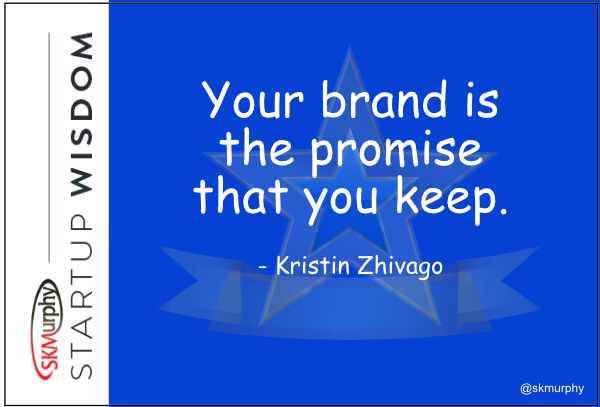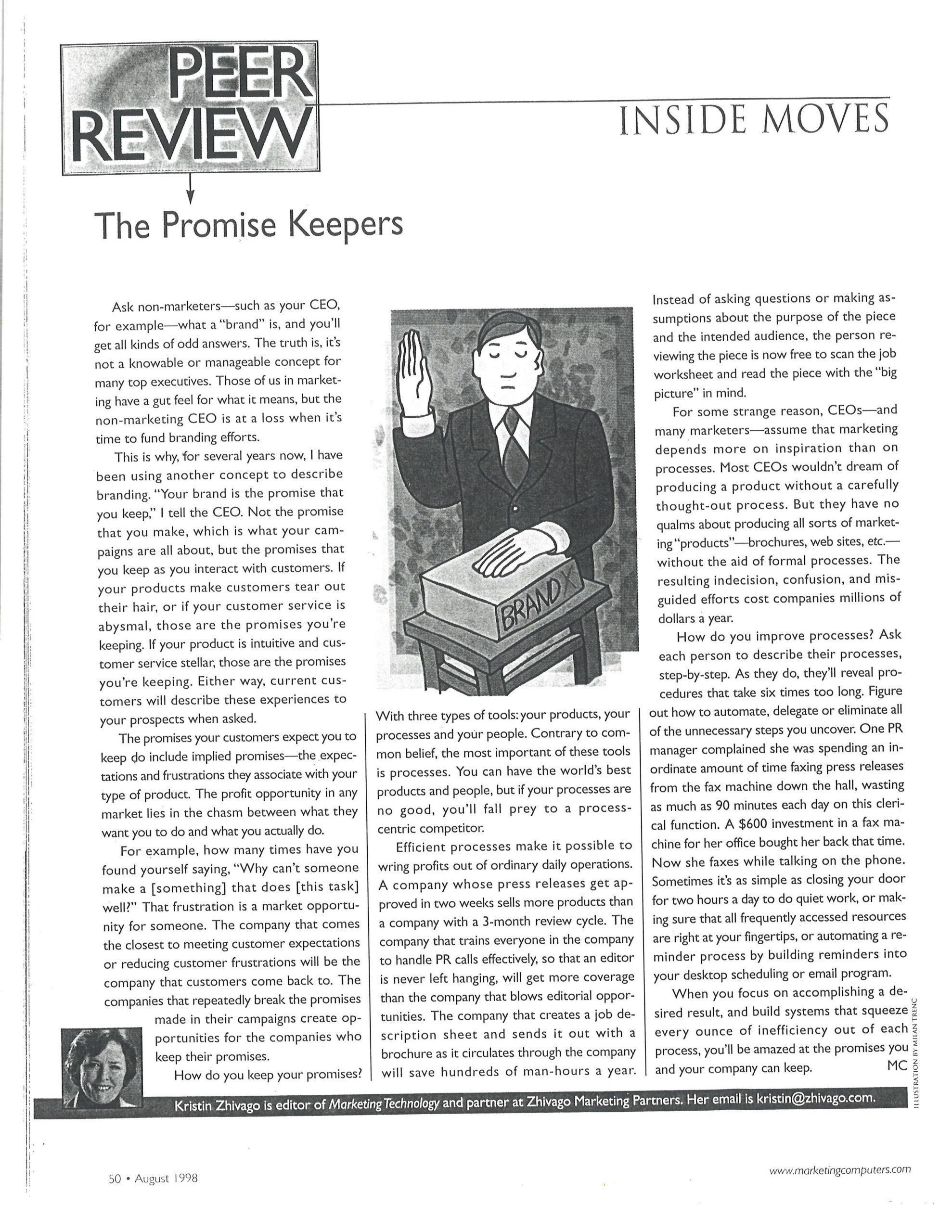Kristin Zhivago’s “The Promise Keeper” outlined the need for business processes that support your brand as the promise that you keep.
This blog post is reprinted from an August 1998 article by Kristin Zhivago in the Marketing Computers trade publication. The article is available in the Internet Archive but no longer appears to be available on an active web page, a link to a scanned image is provided below. When I first read this article in 1998 I was immediately impressed by her succinct definition of brand promise and the clear explanation for why your business processes must be designed (or re-designed as the case may be) to support that promise.
Kristin Zhivago: The Promise Keeper
Ask non-marketers – such as your CEO, for example-what a “brand” is, and you’ll get all kinds of odd answers. The truth is, it’s not a knowable or manageable concept for many top executives. Those of us in marketing have a gut feel for what it means, but the non-marketing CEO is at a loss when it’s time to fund branding efforts.
This is why, for several years now I have been using another concept to describe branding. “Your brand is the promise that you keep,” I tell the CEO. Not the promise that you make, which is what your campaigns are all about, but the promises that you keep as you interact with customers. If your products make customers tear out their hair, or if your customer service is abysmal, those are the promises you’re keeping. If your product is intuitive and customer service stellar, those are the promises you’re keeping. Either way, current customers will describe these experiences to your prospects when asked.
The promises your customers expect you to keep do include implied promises–the.expectations and frustrations they associate with your type of product. The profit opportunity in any market lies in the chasm between what they want you to do and what you actually do.

For example, how many times have you found yourself saying, “Why can’t someone make a [something] that does [this task] well” That frustration is a market opportunity for someone. The company that comes the closest to meeting customer expectations or reducing customer frustrations will be the company that customers come back to. The companies that repeatedly break the promises made in their campaigns create opportunities for the companies who keep their promises.
How do you keep your promises?
With three types of tools: your products, your processes and your people. Contrary to common belief, the most important of these tools is processes. You can have the world’s best products and people, but if your processes are no good, you’ll fall prey to a process-centric competitor.
Efficient processes make it possible to wring profits out of ordinary daily operations. A company whose press releases get approved in two weeks sells more products than a company with a 3-month review cycle. The company that trains everyone in the company to handle PR calls effectively, so that an editor is never left hanging, will get more coverage than the company that blows editorial opportunities. The company that creates a job description sheet and sends it out with a brochure as it circulates through the company will save hundreds of man-hours a year.
Instead of asking questions or making assumptions about the purpose of the piece and the intended audience, the person reviewing the piece is now free to scan the job worksheet and read the piece with the “big picture” in mind.
For some strange reason, CEOs-and many marketers-assume that marketing depends more on inspiration than on processes. Most CEOs wouldn’t dream of producing a product without a carefully thought-out process. But they have no qualms about producing all sorts of marketing “products”–brochures, web sites, etc.–without the aid of formal processes. The resulting indecision, confusion, and misguided efforts cost companies millions of dollars a year.
How do you improve processes?
 Ask each person to describe their processes’ step-by-step. As they do, they’ll reveal procedures that take six times too long. Figure out how to automate, delegate or eliminate all of the unnecessary steps you uncover. One PR manager complained she was spending an inordinate amount of time faxing press releases from the fax machine down the hall, wasting as much as 90 minutes each day on this clerical function, a $600 investment in a fax machine for her office bought her back that time. Now she faxes while talking on the phone. Sometimes it’s as simple as closing your door for two hours a day to do quiet work, or making sure that all frequently accessed resources are right at your fingertips, or automating a reminder process by building reminders into your desktop scheduling or email program.
Ask each person to describe their processes’ step-by-step. As they do, they’ll reveal procedures that take six times too long. Figure out how to automate, delegate or eliminate all of the unnecessary steps you uncover. One PR manager complained she was spending an inordinate amount of time faxing press releases from the fax machine down the hall, wasting as much as 90 minutes each day on this clerical function, a $600 investment in a fax machine for her office bought her back that time. Now she faxes while talking on the phone. Sometimes it’s as simple as closing your door for two hours a day to do quiet work, or making sure that all frequently accessed resources are right at your fingertips, or automating a reminder process by building reminders into your desktop scheduling or email program.
When you focus on accomplishing a desired result, and build systems that squeeze every ounce of inefficiency out of each process, you’ll be amazed at the promises you and your company can keep.
About Kristin Zhivago
Kristin Zhivago (@KristinZhivago) is President of Zhivago Marketing Partners, a digital marketing agency that provides strategy, research, and implementation services that increase revenue. Her book “Roadmap to Revenue” provides detailed practical guidance for how to organize your marketing and sales efforts to align with your how your customer wants to buy.
SKMurphy Take
This short article provides a succinct encapsulation of three key ideas:
- Determine what your customers value in your offering. Although she does not use the phrase “job-to-be-done,” it’s implicit in her framing of a market opportunity as a customer asking, “Why can’t someone make a [something] that does [this task] well.”
- Your marketing efforts should be viewed as a repeatable, scalable process with clear performance metrics. From the perspective of 2021, this seems like a given, but in 1998 the concept of “marketing operations” (and related acronym MOPS) was still very much an evolving methodology for technology products.
- Improve or re-engineer your internal processes to guarantee the value customers are paying for and support your customer’s preferred buying process. It’s good if your brand promise is relevant and differentiated, but it does not mean anything if you don’t keep it.
Zhivago would expand on these concepts in detail 13 years later in her 2011 “Roadmap to Revenue: How to sell the way your customers want to buy.” She offers a holistic view of customer discovery, marketing, and sales that incorporates value stream analysis and post-sale “why did they buy” and “loss” interviews to verify and refine current methods.
Related Blog Posts
- Why is it so hard to get your first ten customers?
Determining need is not enough. You also have to offer a brand promise, which is a commitment to deliver measurable value to their business with your product. - 40 Tips for B2B Customer Development Interviews
Tips for determining customer needs: what job will they hire your product to do. - The Business is Everyone’s Business: Part 1 and Part 2
Jack Stack’s “The Great Game of Business” offers some useful models for fostering a shared understanding of the current challenges to enable effective joint action. - Scale by Understanding Your Value Stream: Slides and Video Recap
A good explanation, with examples, of value stream engineering. - xMentium Reframes Contract Management as Faster Deals
I thought this was a good example of a new entrant looking at an established category and realizing what the customer really wanted to pay for.
